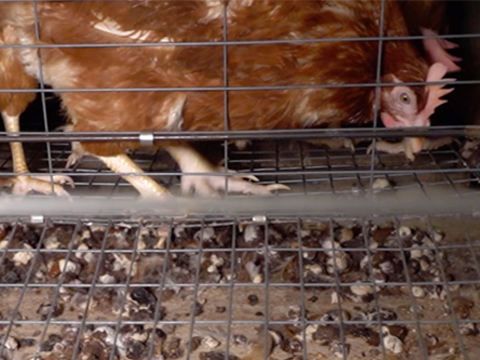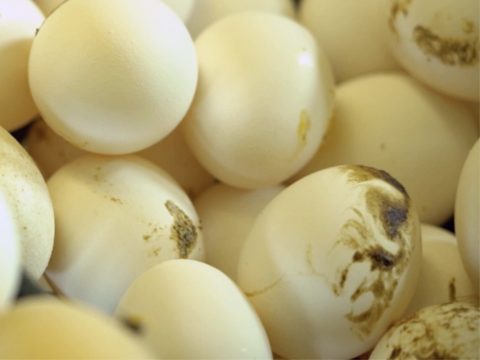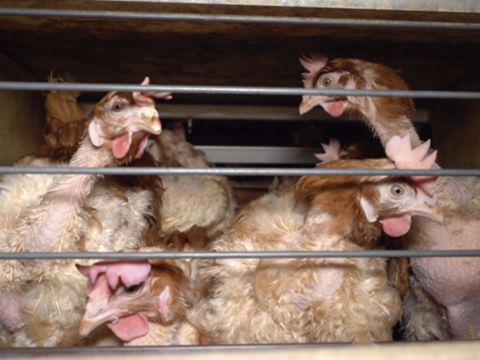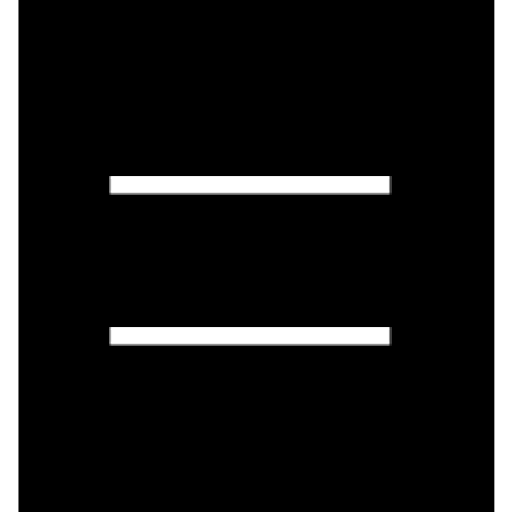

食品安全風險和虐畜罪
牛奶國際(現為DFI零售集團):汙染和食品安全風險
項駭人聽聞的調查顯示牛奶國際(現為DFI零售集團)的雞蛋供應鏈存在汙染和食品安全風險。
您有在惠康或者Market Place by Jasons購物的習慣嗎?一項調查顯示,牛奶國際(現為DFI零售集團)旗下的惠康和Market Place by Jasons出售的雞蛋來自於骯臟的叠層雞籠,具有極高的食品安全風險。
經過對牛奶國際(現為DFI零售集團)的雞蛋供應商進行調查發現,雞舍產蛋欄上堆積著糞便和汙垢結塊,離雞蛋和雞僅咫尺之遙。母雞的一生都被關在叠層雞籠裏。這種籠子又小又殘忍,在世界上大多數國家都是非法的。除此之外,野生禽鳥在農場來去自由,造成了禽流感傳播的嚴重風險。
幾乎所有的亞洲大型跨國食品零售商都承諾只銷售能夠自由出籠的雞產的蛋,包括City Super、Tesco、METRO、Aldi和家樂福。但牛奶國際不同,它一直對外出售的是來自骯臟、殘忍的叠層雞籠的雞蛋。
必須讓牛奶國際(現為DFI零售集團)停止這種行為,這不僅無視食品安全對消費者造成的身體危害,還存在嚴重的虐待動物罪。牛奶國際必須符合行業標準,承諾只銷售能夠自由出籠的雞產的雞蛋。
請在請願書上簽名!
牛奶国际 (現為DFI零售集團):在您跟進同業的做法停止供應骯髒、不人道的籠養雞蛋之前,我將不會在您旗下的惠康超市和Market Place by Jasons消費。請求牛奶公司轉型支持100%非籠飼雞蛋!

籠飼雞蛋的食物安全風險
數十份食品安全科學研究一致發現籠飼蛋場感染沙門氏菌明顯較高。歐洲食品安全局(European Food Safety Authority)在針對此議題進行有史以來最大規模的研究,分析來自5000座牧場的資料,發現籠飼農場感染沙門氏菌的可能性比起放養農場高出25倍。 (1, 2, 3, 4, 5, 6, 7, 8, 9, 10, 11, 12, 13, 14, 15, 16, 17).
將母雞限制在籠子中會增加食品安全風險的原因很多,美國農業部表示將母雞終身關在籠子所產生的壓力,使其更容易患病,且籠子特別難以清潔和消毒,導致籠子上有「大量糞便和灰塵的污染」 (18, 19, 20, 21, 22, 23)
籠飼雞蛋是殘忍的
就像狗和貓一樣,雞是聰明的,是個會感到快樂和痛苦的聰明個體,限制動物一生在狹小幾乎無法轉身的空間是錯誤的。(24)
籠飼系統對動物太殘忍以至於數十個國家是禁止使用的,世界上每一個主流動物保護組織都譴責將產蛋母雞限制在籠子裡是殘忍且不人道的。(25, 26, 27)
這裡有幾個組織的說法:

「在這類籠養蛋場的【格子籠】裡,蛋雞連伸展翅膀或飛上枝頭棲息這些最簡單的自然行為都無法進行。愛護動物協會深切關注這數以百萬計蛋雞的福利。」
香港愛護動物協會

「格子籠飼養蛋雞極不人道,不僅飼養密度高,也剝奪了蛋雞洗沙浴、築巢的權利。飲食業應開始選用人道的放養雞蛋,讓台灣能夠盡快地跟上國際社會的步伐,確保動物福利。」
台灣防止虐待動物協會

「格子笼饲养蛋鸡极不人道,不仅饲养密度高,也剥夺蛋鸡洗沙浴、筑巢。。。饮食产业也应开始选用友善鸡蛋,让台湾能够尽快地跟上国际脚步,确保动物福利。 」
世界動物保護協會
我們引用的是這些組織過去已公開發佈的內容,這些組織與此網站以及特定的系列活動無關。

層架雞籠
牛奶國際持續供應消費者骯髒殘忍的籠飼雞蛋

骯髒
在這些頂好及Market Place by Jasons雞蛋供應商的畜牧場,糞便覆蓋在設備上,亦沾污了雞蛋

殘忍
每一隻母雞幾乎終身關在非常小的籠子裡,幾乎無法活動
文檔和引文
可从此处下载高品质的影片和照片,网站上所有影片和照片都是公开的,任何人(包括媒体)都可以免费下载和使用。
影片和照片分别在:
• 桂園自然生態農場台灣的Jasons Market Place的供應商以品牌名稱ColorEgg
• 佳縈畜牧場台灣的頂好及Jasons Market Place的供應商在品牌名稱Golden Fresh
• 宋怡臻畜牧場龢洪麗珠畜牧場誰提供雞蛋給勤億蛋品科技台灣的頂好及JASONS Market Place的供應商
• Chew’s Agriculture PTE LTD香港的惠康及MarketPlace by Jasons的供應商以Chews Eg-Pro品牌命名
• Sunny Queen Farms 香港的惠康及MarketPlace by Jasons的供應商以商標Sunny Queen為名
全球定位系統 (GPS) 和影片證明了這些片段來自牛奶國際的雞蛋供應商在這裡可用。
Equitas是總部位於英國的全球非營利組織,致力於全球食品供應鏈中的消費者保護和動物福利。
以下是針對食品安全和動物虐待部分的科學研究引文
1: Van Hoorebeke S, Van Immerseel F, Schulz J, et al. 2010. Determination of the within and between flock prevalence and identification of risk factors for Salmonella infections in laying hen flocks housed in conventional and alternative systems. Preventive Veterinary Medicine 94(1-2):94-100.
2: Snow LC, Davies RH, Christiansen KH, et al. 2010. Investigation of risk factors for Salmonella on commercial egg-laying farms in Great Britain, 2004-2005. Veterinary Record 166(19):579-86.
3: 2010. Annual Report on Zoonoses in Denmark 2009. National Food Institute, Technical University of Denmark.
4: Van Hoorebeke S, Van Immerseel F, De Vylder J et al. 2010. The age of production system and previous Salmonella infections on farm are risk factors for low-level Salmonella infections in laying hen flocks. Poultry Science 89:1315-1319.
5: Huneau-Salaün A, Chemaly M, Le Bouquin S, et al. 2009. Risk factors for Salmonella enterica subsp. Enteric contamination in 5 French laying hen flocks at the end of the laying period. Preventative Veterinary Medicine 89:51-8.
6: Green AR, Wesley I, Trampel DW, et al. 2009 Air quality and bird health status in three types of commercial egg layer houses. Journal of Applied Poultry Research 18:605-621.
7: Schulz J, Luecking G, Dewulf J, Hartung J. 2009. Prevalence of Salmonella in German battery cages and alternative housing systems. 14th International congress of the International Society for Animal Hygiene: Sustainable animal husbandry : prevention is better than cure. pp. 699-702. http://www.safehouse-project.eu/vars/fichiers/pub_defaut/Schulz_Salmonella_ISAH%202009.ppt.
8: Namata H, Méroc E, Aerts M, et al. 2008. Salmonella in Belgian laying hens: an identification of risk factors. Preventive Veterinary Medicine 83(3-4):323-36.
9: Mahé A, Bougeard S, Huneau-Salaün A, et al. 2008. Bayesian estimation of flock-level sensitivity of detection of Salmonella spp. Enteritidis and Typhimurium according to the sampling procedure in French laying-hen houses. Preventive Veterinary Medicine 84(1-2):11-26.
10: Pieskus J, et al. 2008. Salmonella incidence in broiler and laying hens with the different housing systems. Journal of Poultry Science 45:227-231.
11: European Food Safety Authority. 2007. Report of the Task Force on Zoonoses Data Collection on the Analysis of the baseline study on the prevalence of Salmonella in holdings of laying hen flocks of Gallus gallus. The EFSA Journal 97. www.efsa.europa.eu/EFSA/efsa_locale-1178620753812_1178620761896.htm.
12: Snow LC, Davies RH, Christiansen KH, et al. 2007. Survey of the prevalence of Salmonella species on commercial laying farms in the United Kingdom. The Veterinary Record 161(14):471-6.
13: Methner U, Diller R, Reiche R, and Böhland K. 2006. [Occurence of salmonellae in laying hens in different housing systems and inferences for control]. Berliner und Münchener tierärztliche Wochenschrift 119(11-12):467-73.
14: Much P, Österreicher E, Lassnig. H. 2007. Results of the EU-wide Baseline Study on the Prevalence of Salmonella spp. in Holdings of Laying Hens in Austria. Archiv für Lebensmittelhygiene 58:225-229.
15: Stepien-Pysniak D. 2010. Occurrence of Gram-negative bacteria in hens’ eggs depending on their source and storage conditions. Polish Journal of Veterinary Sciences 13(3):507-13.
16: Humane Society International, “An HSI Report: Food Safety and Cage Egg Production” (2010). HSI Reports: Farm Animal Protection. 3. http://animalstudiesrepository.org/hsi_reps_fap/3
17: European Food Safety Authority. 2007. Report of the Task Force on Zoonoses Data Collection on the Analysis of the baseline study on the prevalence of Salmonella in holdings of laying hen flocks of Gallus gallus. The EFSA Journal 97. www.efsa.europa.eu/EFSA/efsa_locale-1178620753812_1178620761896.htm
18: The Danish Veterinary and Food Administration. 2004. The national Salmonella control programme for the production of table eggs and broilers 1996-2002. Fødevare Rapport 6, March.
19: Davies R and Breslin M. 2003. Observations on Salmonella contamination of commercial laying farms before and after cleaning and disinfection. The Veterinary Record 152(10):283-7.
20: Methner U, Rabsch W, Reissbrodt R, and Williams PH. 2008. Effect of norepinephrine on colonisation and systemic spread of Salmonella enterica in infected animals: Role of catecholate siderophore precursors and degradation products. International Journal of Medical Microbiology 298(5-6):429-39.
21: Bailey MT, Karaszewski JW, Lubach GR, Coe CL, and Lyte M. 1999. In vivo adaptation of attenuated Salmonella Typhimurium results in increased growth upon exposure to norepinephrine. Physiology and Behavior 67(3):359-64.
22: Shini S, Kaiser P, Shini A, and Bryden WL. 2008. Biological response of chickens (Gallus gallus domesticus) induced by corticosterone and a bacterial endotoxin. Comparative Biochemistry and Physiology. Part B. 149(2):324-33.
23: Rostagno MH. 2009. Can stress in farm animals increase food safety risk? Foodborne Pathogens and Disease 6(7):767-76.
24: Marino, L. 2017. Thinking chickens: a review of cognition, emotion, and behavior in the domestic chicken. Animal Cognition 20(2): 127–147.
25: “European_Union_Council_Directive_1999/74/EC.” Wikipedia: The Free Encyclopedia. Wikimedia Foundation, Inc. Web 03 August 2018, en.wikipedia.org/wiki/European_Union_Council_Directive_1999/74/EC
26: “Farm Animal Confinement Bans.” American Society for the Prevention of Cruelty to Animals. Web. 03 August 2018, www.aspca.org/animal-protection/public-policy/farm-animal-confinement-bans
27: World Organization for Animal Health, “Terrestrial Animal Health Code” (2017). www.rr-africa.oie.int/docspdf/en/Codes/en_csat-vol1.pdf

